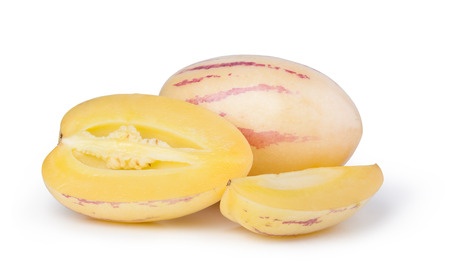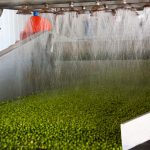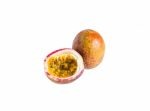
The pepino fruit (Solanum muricatum Ait.), (a.k.a. melon pear, pepino dulce, sweet cucumber) is native to the Andes of South America, but now grown commercially in Chile and Peru Japan, Australia, New Zealand, U.S.A and even Europe (Huyskens-Keil et al., 2006). It was grown prior to the Spanish Conquest and lost favour until recently (Prohens et al., 1996) when it has started to attract stronger commercial interest.
The shrub is evergreen and frost-sensitive. The fruit comes in a variety of sizes, shapes, and colour depending on the cultivar. The most common cultivar is Toma but Golden Splendour is also popular. Sweet Round and Sweet Long have been developed for European cultivation (Ruiz et al., 1997). Although perennial, the best yields are obtained when cultivated as an annual. Good fruit set occurs with mild days (12-25 °C) and cool nights to obtain the best fruit (Dennis et al., 1985). The fruit can weigh from 0.1kg to 0.5kg and is on average nearly 92% water although the soluble solids content is between 6 and 12%. The fruit colour ranges from pale green to yellow with purple stripes.
It’s flavour is similar to a canteloupe melon being highly aromatic and juicy (Martinez-Romero et al., 2003). Knowing when it is ripe has been one of the issues for the modern grower and one method has been to look at the sugar content (Sanchez et al., 2000). It’s also grown for its nutritional value being very rich in minerals such as calcium, phosphorus, and potassium, but low in calories. It contains a wider variety of vitamins than other fruits such as thiamin, niacin, riboflavin, and ascorbic acid (vitamin C), which provide antioxidant advantages (Sudha et al., 2011). A full analysis was conducted by Redgewell and Turner (1986). The pepino is a versatile fruit and can be consumed in many ways depending on which stage in maturity. Like much fruit that must be shipped, it is picked at an early phase of ripening to enable the fruit to be presented at its optimum appearance for the consumer, but it bruises easily and there is a high loss during transport. Controlled atmospheric storage is ideal here for this fruit. When it is in its early ripening stage (green) it can be used as a vegetable in stews. When ripe it is often consumed as a dessert fruit, and as an ingredient of fruit salads, in juices, or in ice cream (Martinez-Romero et al., 2003).
References
Ahumada, M., & Cantwell, M. (1996). Postharvest studies on pepino dulce (Solanum muricatum Ait.): maturity at harvest and storage behaviour. Postharvest Biology and Technology, 7, 129–136.
Dennis, D.J., Burge, G.K. and Lill, R., (1985) Pepinos: cultural techniques. Information Services, Ministry of Agriculture, Wellington, N.Z., 2 pp.
Huyskens-Keil, S., Prono-Widayat, H., Lüdders, P., Schreiner, M. (2006) Postharvest quality of pepino (Solanum muricatum Ait.) fruit in controlled atmosphere storage. J Food Eng. 77 pp. 628–34.
Martinez-Romero D, Serrano M, Valero D. 2003. Physiological changes in pepino (Solanum muricatum Ait.) fruit stored at chilling and non-chilling temperatures. Postharvest Biol. Technol. 30: pp. 117–86.
Prohens, J., Ruiz, J.J., Nuez, F. (1996) The pepino (Solanum muricatum, Solanaceae): A “New” crop with a history. Economic Botany 50(4) pp. 355-368
Ruiz , J. J, Prohens, J. Nuez, F. (1997) `Sweet Round’ and `Sweet Long’: two pepino cultivars for mediterranean climates. Hortscience 32: pp. 751- 752
Sánchez, M., Cámara, M., Prohens, J., Ruiz, J.J., Torija, E. Nuez, F, (2000) Colour characteristics and composition of improved pepino cultivars at three ripening stages. Gartenbauwissenschaft 65: pp. 83- 87
Sudha, G., Sangeetha, P.M., Indhu Shree, R., Vadivukkarasi, S. (2011) Antioxidant Activity Of Ripe Pepino Fruit (Solanum muricatum Aiton). Int. J. Pharmacy Pharmaceutical Sci., 3(3) 5 pp. http://www.ijppsjournal.com/Vol3Issue3/2296.pdf



It’s something I’m looking at breeding, my own aims would be to keep flavour consistent, breed for earlier ripening and cooler summer climates, no “soapy aftertaste” and for less variation in seedlings so seeds breed true.
With all of that I reckon it would make a good garden crop, a nice alternative to melons in greenhouses in the northern hemisphere.
I think it has potential and many areas are already growing tomatoes in greenhouses on an industrial scale.
A small plant that can be grown under glass (and hopefully one day outdoors) as an annual crop and produce a good sized fruit in large quantities sounds like a winner to me.
If all the faults could be overcome it could be sold in stores in a similar fashion to tomatoes at a very affordable price and grown by gardeners alongside tomatoes.
I suspect it would be something of a niche fruit at first if this did come true, but maybe it would eventually take off unlike Phyasalis which here at least seem to be something of a peculiaritity still.
I eat pepinos this way by sprinkling the cut fruit with a dusting of ground ginger, cinnamon and sugar. Let the dish stand for a while and serve with full cream or ice-cream. It also works with savoury dishes like melon, as I wrap proscuttio or other Italian ham around slices of the fruit. There are some good pepino recipes here http://www.edible.co.nz/recipes/pepino.htm but they are pretty much anywhere on the web.